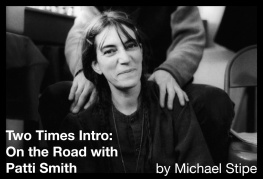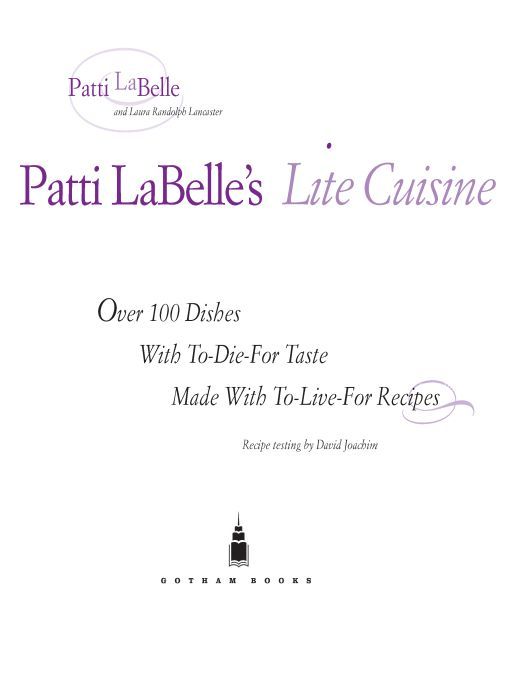Table of Contents
Also by Patti LaBelle and Laura Randolph Lancaster
Dont Block the Blessings
LaBelle Cuisine
Pattis Pearls
GOTHAM BOOKS
Published by the Penguin Group
Penguin Putnam Inc., 375 Hudson Street, New York, New York 10014, U.S.A.
Penguin Books Ltd, 80 Strand, London WC2R ORL, England
Penguin Books Australia Ltd, 250 Camberwell Road, Camberwell, Victoria 3124, Australia
Penguin Books Canada Ltd, 10 Alcorn Avenue, Toronto, Ontario, Canada M4V 3B2
Penguin Books (NZ) Ltd, Cnr Rosedale and Airborne Roads, Albany, Auckland 1310, New Zealand
Penguin Books Ltd, Registered Offices: Harmondsworth, Middlesex, England
Published by Gotham Books, a division of Penguin Putnam Inc.
First printing, April 2003
Copyright Patti LaBelle and Laura Randolph Lancaster, 2003
All rights reserved
Gotham Books and the skyscraper logo are trademarks of Penguin Putnam Inc.
LIBRARY OF CONGRESS CATALOGING-IN-PUBLICATION DATA
LaBelle, Patti.
Patti LaBelles Lite Cuisine: Over 100 dishes with to-die-for taste made with to-live-for recipes / Patti LaBelle and Laura Randolph Lancaster. p. cm.
eISBN : 978-1-440-65036-9
1. Cookery, American. 2. Low-fat dietRecipes. I. Title: Patti LaBelles Lite Cuisine: Over one hundred dishes with to-die-for taste made with to-live-for recipes. II. Lancaster, Laura Randolph. III. Title.
TX715 .L128 2003
641.3638dc21
2002155237
Set in Simoncini Garamond and Franklin Gothic
Without limiting the rights under copyright reserved above, no part of this publication may be reproduced, stored in or introduced into a retrieval system, or transmitted, in any form, or by any means (electronic, mechanical, photocopying, recording, or otherwise), without the prior written permission of both the copyright owner and the above publisher of this book.
The scanning, uploading, and distribution of this book via the Internet or via any other means without the permission of the publisher is illegal and punishable by law. Please purchase only authorized electronic editions, and do not participate in or encourage electronic piracy of copyrighted materials. Your support of the authors rights is appreciated.
This book is printed on acid-free paper.
http://us.penguingroup.com
Acknowledgments
This book is the result of the efforts of numerous people who gave generously of their time and talent to make its publication possible. I would like to acknowledge them here for their many contributions.
Thanks to David Joachim, recipe developer and tester extraordinaire, whose talent, troubleshooting, and truly spectacular cooking skills made these recipes sing.
Thanks to the talented team at the American Dietetic AssociationJeannette F. Jordan, Registered Dietitian (RD), Certified Diabetes Educator (CDE); Jane Stephenson, RD, CED; Alison B. Evert, RD, CDEfor their informative insights and impeccable nutritional analysis. Just one question: Does the Diabetes Care and Education Practice Group of the American Dietetic Association know how lucky they are to have you three as members?
Thanks to American Dietetic Association Publisher Diana Faulhaber, who contacted, coordinated, and coolly coaxed the many comments of the ADA contributors with remarkable poise and professionalism and uncanny skill and style.
Thanks to Lori Ferme, American Dietetic Association Media Relations Manager, whose enthusiasm and excitement for this book was immediate, inspiring, and infectious.
Thanks to Rick Rodgers for just the right recommendation at just the right time.
Thanks to William R. Frederick, MD, who helped in so many ways that only he knows.
Thanks to Al Lowman for his enlightening guidance and advice.
Thanks to Carl Gullette for his heirloom photographsand for all his help with research and remembrance.
Thanks to Patti Webster for her special and spectacular public relations skillsand her spiritual support.
Thanks to Armstead Edwards for managing the many and complex details that transform a book you have in your head into a book you can hold in your hand.
Thanks to William Shinker and the Gotham Books family for believing in this book from the start.
Thanks to Ronny B. Lancaster for opening his home, his heartand his kitchen!to me. But most of all for loving and supporting my sister-friend and coauthor through every phase of this book. Im talking start to finish. Intro to ending. Deal to deadline.
And last, but by no means least, a very special and heartfelt thanks to Laura Randolph Lancaster, my coauthor and sister-friend, whose patience, professionalism, and profound gifts and talent made this book possible from concept to creation.
Foreword
A few years ago, I was preparing an invited lecture for a group of physicians on the topic of new directions in medical nutrition therapy. I had reviewed a number of recent studies that focused on comparing the effect of reduced-calorie diets with and without exercise on weight loss in obese persons. The review of these studies was not especially illuminating except for a revelation that was crystallized for me during the process: in the course of medical training, very little serious attention was paid to the appropriate use of diet therapy and exercise in the treatment of several of the worst diseases of our timecoronary heart disease, hypertension, diabetesthe list goes on and on.
And yet well over 100 million Americans are affected by these diseases, and in each case, the treatment approach begins with diet therapy and exercise. Not medication. Not surgery. Diet and exercise. This approach makes good sense because the proper use of lower-calorie diets coupled with regular programs of moderate exercise indeed results in weight loss and improvement in all of these conditions. Thus, the first line of therapy for those conditions that constitute the major epidemics of our time relates to one simple factor: how we eat.
The importance of a more sensible approach to our eating habits has never been more apparent in our society. We are witnessing a rise in the number of overweight and obese adults to levels of 50 percent or more. Levels of obesity in children and adolescents are also rising sharply. These statistics are particularly disturbing when you consider the long list of serious, potentially lethal, illnesses directly linked to obesityheart disease, high blood pressure, and stroke, to name a few. Then there is diabetes. As a result of the sharply rising obesity levels, there is an explosive epidemic of type 2 diabetes. Thats the bad news. The good news is that it has now been proven with an important federally funded clinical trial that even those persons who are obese and at a high risk for type 2 diabetes can prevent the development of the disease by the use of two techniques: diet therapy and exercise. Consequently, our ability to manage and to prevent some of the most damaging diseases in our society, for all people, depends heavily on our society taking a more balanced and sensible approach to our food choices and eating habits.









